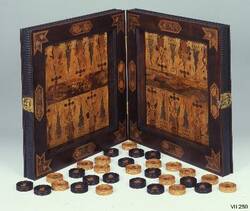Here you see one of the loveliest board games made in the seventeenth century. The Heir Apparent to the throne of Saxony, Johann Georg – who had a fine artistic sense – presented it to his father, Johann Georg the First, on the ruler’s seventieth birthday.
It’s the work of Johann Georg Fischer, a master of the art of marquetry. This wood-inlay technique was used to decorate furniture, cases and – as you see here – game boards. Fischer came from the West Bohemian town of Egar. In the seventeenth century, Eger was famous for its relief marquetry, using precious woods.
The case contains a game of tric trac – on the other side of which is a chessboard.
The front of the case depicts the Battle of Zama – the decisive engagement of the Second Punic War, in 202 A.D. That’s when the Roman general Scipio Africanus defeated the Carthiginian forces under the command of Hannibal. The battle of the two great generals was an eminently suitable subject for the decoration of a chess set! Johann Georg Fischer based the scene on an engraving by Matthias Merian.
In the centre, a Roman soldier uses his lance to topple a Carthiginian from his mount. On the left, a rider spurs his horse. On the right, a fallen warrior uses his shield to try and defend himself from an attacker. In the background, a number of smaller Roman soldiers engage with the elephants which Hannibal had brought across the Alps. At the bottom of the scene you see an explanation in Latin – written in minute letters made out of tiny slivers of wood.
On the back, you see the chessboard. The borders are decorated with flowers, and together, the individual chessboard squares comprise a veritable garden of fruit, vegetables and flowers! On the dark squares you see various blossoms – tulips, carnations, roses and narcissi. The light squares feature vegetables and fruits – carrots, pumpkins, strawberries, plums and nuts. It could almost be a botanical textbook!
The fifteen light-coloured pieces bear the portraits of German kings and emperors. The fifteen dark ones display the likenesses of Roman emperors. They were probably never used. As a result, it's one of the few chess sets from the seventeenth century which is still complete.
The decoration of the tric trac game continues the theme of military engagement. In intricate marquetry, Fischer has created a land battle on the right... and a sea battle on the left. Look at the land battle first. Infantry and cavalry are besieging a city. Flames shoot out of the houses. The sparks are tiny splinters of brass. The soldiers are also minuscule. Yet each of them is composed of individual limbs – head, hat and weapon. You probably need a magnifying glass to make out the detail. The artist himself certainly used one to create this picture.
Now if you look closely at the left-hand area of the tric trac game, you can probably make out a life-size fly – under the section with the sailing ships. The fly’s feelers, legs, wings and eyes are made out of the tiniest pieces of wood. In fact, each leg is made up of several little pieces!
Barely legible – because it’s so small – is the artist’s signature in Latin: Johann Georg Fischer made this in 1655.
Further Media
- Location & Dating
- Eger. Dated 1655.
- Material & Technique
- various woods, ivory, brass, some silver pins on the game pieces
- Dimenions
- H 54,0 cm, B 54,5 cm, T 13,0 cm
- Museum
- Grünes Gewölbe
- Inventory number
- VII 250
